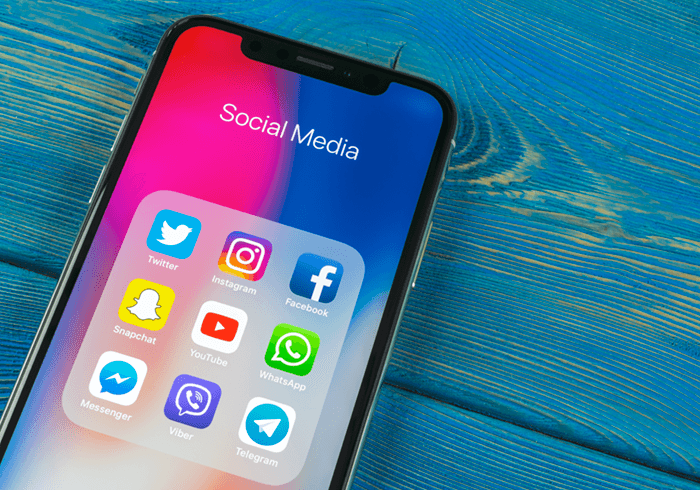By Melissa Stefanec
 These days, you don’t often hear the word ‘social’ used on its own. We often pair it with media. Even if it’s used on its own, we all know what kind of “social” people are referencing — the virtual kind. However, this is a relatively new development.
These days, you don’t often hear the word ‘social’ used on its own. We often pair it with media. Even if it’s used on its own, we all know what kind of “social” people are referencing — the virtual kind. However, this is a relatively new development.
If you’re into etymology (or, for those of you who haven’t had your morning cold brew yet, the study of how the meaning of words changes over time), make today’s case study the evolution of the word “social.” There was a time when the word had more to do with ancient fraternity than media, but times change.
Most of us have drastically changed how we socialize. Today, when it comes to people we don’t work with, a lot of us have more interactions with screens than human beings. Sometimes, that’s a good thing. Other times, it’s a terrible thing.
The Paradox
I don’t have enough time or energy to debate whether or not social media will spur the collapse of society. However, I have just enough time to discuss an interesting nuance of social media: it’s an unusual form of socializing in that the more I engage with it, the less connected to humanity I actually feel. Social media isn’t a true way to connect with other human beings, at least those in my closest circle. It takes the edge off loneliness and eases the pain of geographic separation from people I care about. It’s not the same as a phone call or physical presence.
We all know and feel that. Yet, we expect more of social media than it’s capable of delivering and end up disappointed. Nonetheless, we are unable to detach from it. I think social media is a good starting point for socialization, but it shouldn’t be the end goal of socializing.
Breaking the Habit
A recent survey from GlobalWebIndex found many people spend almost two and a half hours a day on social media channels. That’s a lot of time spent pseudo-engaging with your fellow humans. For many us, cruising social media is a habit, one that is easy to feed and hard to avoid.
Habits are very important to humans. When we memorize and perform the same tasks over and over again, our brains have to spend less time consciously thinking about those tasks. This frees up brain power and allows us to focus on other tasks while we are engaging in the habitual one. Our brains love habits, and this makes those habits hard to break. However, humans can be very successful at modifying behaviors. The National Institutes of Health offer the following tips on how to break bad habits:
• Avoid tempting situations.
• Replace unhealthy behaviors with healthy ones.
• Enlist support. Ask friends, family and co-workers to support your efforts to change.
• Reward yourself for small steps.
This article is going to take a closer look at the third bullet in that list — the one that involves enlisting support. In the case of social media, this means persuading others to socialize without screens.
Let’s face it, suggesting to your friends that they slowly step away from their phones might not make you the most popular person at the party. However, stepping away from the screen is just what we need to do in order to put ourselves out in the real, tangible world. So, here are some ideas of how to engage with people in real life and pull yourself out of a social-media-cruising rut.
Ideas for socializing without a screen
• Join a club
Whether you are into biology, philosophy, photography or LARPing, there is a club out there where you can meet your brethren and make connections.
• Join an athletic team
Even if you aren’t a star athlete, there are plenty of club sports to join. Playing on a team is a great way to forge real connections with real people.
• Watch a live sporting event
People love to rally around the home team. Find a friend or two (or 10) and watch the game together. You’ll feel instantly connected.
• Go some place with limited data coverage
If you go to a location where you can’t access the internet, you can’t engage with social media. Every once in a while, all of us need to escape technology.
‘Stepping away from the screen is just what we need to do in order to put ourselves out in the real, tangible world.’
• Host a game night
These things are actually fun. Humans love playing, and games are adult toys. There are multiple games that incorporate your phone but also require you to interact with people. Those games are a great way to incorporate technology in a healthy way.
• Go to a group exercise class
If you’re the sort of person who needs an all-encompassing deterrent, try a group class. You’re going to look a little silly if you’re scrolling through Instagram in the middle of yoga.
• Take a hike/run/paddle with friends
If you’re actively engaging in an activity, you may just forget about social media feeds. Focusing your brain and body on a healthy activity can pay off in a big way.
• Volunteer
Social media has a way of turning even the best-intentioned people into mild narcissists. Volunteering is a great way to look outside yourself and your circles. When you help others, you feel good. Volunteering can be addictive—in the most wonderful way.
• Take in some live theater or an art exhibit
Digesting art takes time and attention, so it’s a great way to interact with something that isn’t a screen. You can also bring friends or family along to add an additional level of engagement.
• See some live music
While you’re there, resist the urge to record large portions of it on your phone or take too many photos. Practice active listening. Put technology off to the side and tune into the music.
• Go to the fair
If you are the sort of person who needs a little nudging or isn’t sure where to start, attend one of SUNY Oswego’s student involvement fairs. More than 200 registered student organizations attend the fair, and these events are a great way for you to evaluate options before you commit. You can contact thepoint@oswego.edu for more information.











